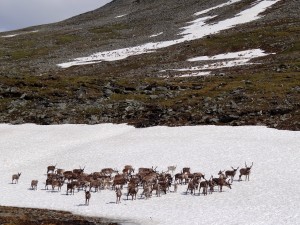Reindeer are a very social species. They form very large herds comprised of adult males and females, as well as calves. This herding behavior offers the protection of numbers to reindeer against predators, such as wolves. The defensive aspect of the herd is highly developed in reindeer. In the presence of a predator, for example, the herd will bunch together and the entire herd will move circularly to make it difficult for the predator to isolate any one individual. The instinct to herd is very strong in reindeer (Vitebsky 23,93).
Reindeer also follow migratory routes for incredibly long time. Herds can follow the same migratory patterns for decades. These predictable patterns of movements allowed hunters to catch and kill reindeer, even if they could move as far or as fast as the reindeer themselves. Hunters waited along the migration routes at natural bottlenecks, such as a narrow mountain pass or a river that could only be crossed in one specific place, and then killed the reindeer when they were bunched together and easier to kill. Reindeer are also naturally curious animals. This also allowed humans to hunt them more easily by creating decoys that attracted the reindeer close enough to the hunters to be killed (Vitebsky 23-24).
Antlers are an important part of reindeer behavior. Reindeer are unique among deer species in that both males and females grow antlers. These antlers are used to fight and establish dominance hierarchies. Hunters exploited this fighting behavior in various ways to capture and kill reindeer more easily. During the mating season, males fight each other with their antlers for females. After the rut, males lose their antlers, while female reindeer keep theirs. This gives pregnant females an advantage over males for food. The females with antlers are able to fight off males for the best food (Smith 10).
Reindeer had and continue to have an enormous impact on humans. During the Upper Paleolithic, about 35,000 years ago, reindeer constituted a large part of early humans’ diet. Anthropologists found sites where it is clear that early humans killed large numbers of wild reindeer. Reindeer were valuable for the meat they provided, but also for their fur and skin that were useful for clothing and for their antlers and bones made strong into tools or weapons (Smith 52).
Domesticated reindeer made life possible for groups of humans living in northern Europe, such as the Sami, Nenets, and Evenki. Nomadic groups followed their reindeer herds’ migrations and lived off what their reindeer provided. Sledges using reindeer teams allowed these people to travel great distances and follow their herds across the entire migration route. Reindeer allowed these groups to live in conditions that are less than hospitable towards humans and continue to do so up to today (Vitebsky).


